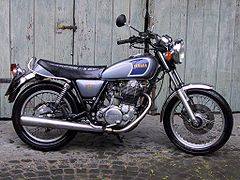
Yamaha SR500
Encyclopedia

Yamaha Motor Company
, is a Japanese motorized vehicle-producing company. Yamaha Motor is part of Yamaha Corporation and its headquarter is located in Iwata, Shizuoka. Along with expanding Yamaha Corporation into the world's biggest piano maker, then Yamaha CEO Genichi Kawakami took Yamaha into the field of motorized...
SR500 is a popular thumper. It first started production in 1978, as a road-going version of the popular Yamaha XT500. It experienced good sales throughout the US, Europe and Australia. The SR500 is no longer sold in any market worldwide, but its sister bike, the SR400, was manufactured in Japan until 2008 when emissions restrictions halted production. In 2010 Yamaha is reintroducing the SR400 with a fuel injection system replacing the carburetor. The SR400 is essentially the same bike as the SR500, but with a shorter stroke and heavier muffler to pass tighter emission restrictions.
The SR500 was well received on conception, largely due to its contemporary styling and reliable Yamaha
single-cylinder 500 cc powerplant. The chassis and engine has served as a popular basis for many café racer
Café racer
A café racer is a type of motorcycle as well as a type of motorcyclist. Both meanings have their roots in the 1960s British counterculture group the Rockers, or the Ton-up boys, although they were also common in Italy, Germany, and other European countries...
s, street trackers and even bobbers
Bobber (motorcycle)
A bobber is a custom motorcycle that usually has had the front fender removed, the rear fender "bobbed" or made smaller, and all superfluous parts removed to make it lighter.- History :...
. SR500's are raced competitively in historic class across the world.
History
Released in 1978, the SR500 was Yamaha’s attempt to cash in on nostalgia for the period when 500-singles were the preferred mount of serious riders. The SR500 eventually led to the SRX600 and Yamaha now produces a 660 road single. Although, the reputation of the SR500 remains so strong that Yamaha has continued to produce it (ending in 2008) both for the Japanese domestic market (in 400 cc form to take advantage of registration laws) and for the European market where its popularity has never diminished.Engineering was reluctant at first
Shiro Nakamura (later also responsible for XS 750 triple, XS 400 twin, XS 1100 four and the SR 500) who developed the XT engine remembers: "When the off road market started booming in the US, bikers remembered the advantages of the good old singles. Soon the sales guys started to request the development of a four stroke for off road. Honestly speaking, we engineers were quite reluctant in the beginning, since we knew about the difficulties of these big thumpers. As soon as they had a bit more power they turned out to be unreliable and they were shaking like hell."Nakamura-san continues, "Now I can confess that developing this first big single was a real nightmare. It was only the second four-stroke designed by Yamaha. We tested many different configurations including DOHC and even cylinder head oil cooling, but the XT was supposed to be simple and reliable and we turned away from all these complicated solutions."
Rollout in 1975 in the US
The first XT 500 was shown at the US dealer convention in September 1975. Europeans had to wait till the summer of 1976 before they could press their boots against the heavy kick-starter.The XT 500 was an instant success and was produced until 1990. It laid the ground for the later range of XT bikes ranging from 125 cc (XT 125) to 750 (XTZ 750) and contributed largely to Yamaha's image.
The XT proved its performance and reliability by winning the first big African rallies, which were on the rise in the late seventies. It started with Paris-Abidjan-Nice and then the godfather of all rallies, the famous Paris-Dakar, which confirmed the supremacy of the XT 500. In France alone 62,000 XT 500's were sold from 1976 to 1990.
SR 500: the thumper for the open road
Shunji Tanaka's idea from the beginning of the XT project, was to develop a street model on the same engine base for the European market. He faced resistance first from marketing people, who were convinced that the big thumper era on the road was definitely dead. "We will only sell some units" he used to hear. Tanaka believed in his intuition and pushed the SR 500 through for the launch in the Japanese market in 1978. While for the XT the priority had been reliability and simplicity, the keyword for this street model was "easy to use". It explains the major difference between the SR and XT engine: the electronic ignition and a clever new concept to make kick start easier. It was a manual decompressor system.Nakamura tells the background story: "It came in fact from an accident! Mr. Morinaga, Yamaha Motor's Technical Director, tested the SR prototype and got a wrench to his ankle as he tried to kick it. Easy starting then instantly became a first priority!"
British design influence
The SR 500 was designed by Atsushi Ishiyama, today President of GK dynamics. He worked on the very first Yamaha and contributed a lot to create Yamaha's reputation in design. He says: "Our choice was to design the new SR 500 with a strong family image and a strong link to our first four stroke, the XS 650 twin, which was also inspired by British design at first."The SR 500 was going to become a legend as one of most reliable and easy-to-maintain motorcycles ever built. It sold until 1999, with a huge demand in Germany and Japan, until new noise and emission regulations signalled the end for this big air-cooled single.

